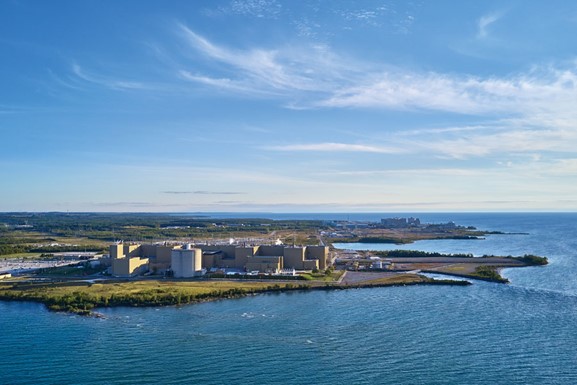Bruce nuclear power plant in Ontario, Canada. (Photo: Bruce Power)
Bruce Power and Isogen, a partnership between Kinectrics and Framatome, have completed the installation of Isogen’s isotope production system (IPS) at Unit 7 of Bruce’s CANDU nuclear power plant in Ontario, Canada, making it the first power reactor in the world with installed capability to produce lutetium-177.
From left to right, Richmond County Technical Career Magnet School (Team 1) students Leila Cortez, Jaidyn Moore, and Tamea Dunnom and teacher Carla Biley won third place in Best Engineering Student Design at the WORCshop@AU event. They are joined by Rick Connolly, SRNS operations and maintenance director and WORCshop@AU judge (second from right).
Savannah River Nuclear Solutions (SRNS), the Department of Energy contractor responsible for the management and operations of the Savannah River Site in South Carolina, partnered with Augusta University to create WORCshop@AU, an education outreach opportunity to introduce local high school students to nuclear science careers by solving a real-world problem. The program concluded on December 9, when student teams presented their solutions during a friendly competition.
From left: Nigel Cann, delivery director at Hinkley Point C, Helen Whately MP, Kwasi Kwarteng MP, and Jean-Bernard Lévy, chairman and chief executive officer of EDF. (Photo: EDF)
Despite last year’s announcement from EDF Energy that the startup of Unit 1 at Hinkley Point C would likely be delayed (from late 2025 to June 2026), current progress at the site is receiving praise from the U.K. government.
On January 13, Kwasi Kwarteng, secretary of state for business, energy, and industrial strategy, and Helen Whately, exchequer secretary of the treasury, toured the nuclear new-build project, accompanied by Jean Bernard Lévy, EDF’s chairman and chief executive.
Czech government officials and company representatives at the January 13 signing. (Photo: Czech Republic Ministry of Industry and Trade)
Westinghouse Electric Company has signed memorandums of understanding with seven companies in the Czech Republic. The MOUs, signed on January 13 at the Ministry of Industry and Trade in Prague, cover cooperation on the potential deployment of a Westinghouse AP1000 reactor at the Dukovany nuclear plant, as well as other potential AP1000 projects in Central Europe.
Schools distributed information about the pilot trial in their communities, and schoolchildren participated in the biweekly release of sterilized male mosquitoes. (Photo: Manuel Fernández, Cuban Agency of Nuclear Energy)
Cuba’s plan to use the sterile insect technique to tackle the spread of dengue—a viral, mosquito-borne disease—relies on expertise and technology from the International Atomic Energy Agency. The technique is not new, having been used to control different insect-vector diseases in diverse regions of the world.
Xiaoluo Wang (right), a fellow under the IAEA Marie Sklodowska-Curie Fellowship Program, graduated last year with a master’s degree in nuclear engineering and is getting work experience at the IAEA's Division of Nuclear Fuel Cycle and Waste Technology. (Photo: A. Tarhi/IAEA)
The International Atomic Energy Agency has selected more than 110 female students from around the world to receive scholarships under its Marie Sklodowska-Curie Fellowship Program.
Launched in 2020 by the IAEA's director general, Rafael Mariano Grossi, the program offers young women an opportunity to pursue studies toward a master’s in the nuclear field by providing financial support and practical experience. Its aim is to help close the gender gap in the traditionally male-dominated nuclear sector, where women make up less than a quarter of the workforce globally, according to data from the World Nuclear Association.
Kurt Terrani observing a chemical vapor infiltration furnace at ORNL during densification of additively manufactured nuclear-grade silicon carbide. (Photo: Carlos Jones/ORNL/DOE)
Ultra Safe Nuclear Corporation (USNC), a Seattle-based reactor developer, has licensed an additive manufacturing technique developed at the Department of Energy’s Oak Ridge National Laboratory to print refractory materials into structural and core components for the company’s microreactor designs.
[CLICK TO VIEW FULL IMAGE] The diagram at left illustrates the experimental setup and the resulting zirconium oxide layer of varying thickness. The second diagram shows the circular zirconium alloy sample that is affected by the band of nickel alloy and radiation. Finally, the electron image at right shows a band of oxidation on the zirconium alloy sample. (Images: Peng Wang, Michigan Ion Beam Laboratory)
A longstanding issue in boiling water reactors—shadow corrosion on zirconium alloy fuel rods and fuel channels—has been reproduced in the Michigan Ion Beam Laboratory as part of an effort to understand and prevent the phenomenon. Research led by Peng Wang, a University of Michigan assistant research scientist in nuclear engineering and radiological sciences, was published in the January 2022 issue of the Journal of Nuclear Materials and described in a recent university news article.








 The International Energy Agency’s newly published in-depth review of Canada’s energy policies, the first since 2015, urges the nation’s government to take more action in support of nuclear energy.
The International Energy Agency’s newly published in-depth review of Canada’s energy policies, the first since 2015, urges the nation’s government to take more action in support of nuclear energy.




